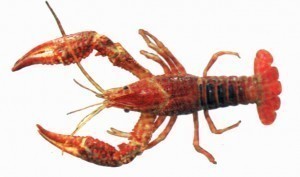Crayfish Sizes
Relative to the lobster, the Crayfish is distinguishable from its cousin through its smaller size. Its size further varies among its many species, which have been divided into 3 separate families.
smaller size. Its size further varies among its many species, which have been divided into 3 separate families.
Indigenous to Europe and the western part of North America, the Astacidae family is composed of 3 genera. Among these is the genus Astacus, which is prevalent all over Europe and areas of western Asia. One of its species is the European crayfish (Astacus astacus) whose males can grow to a length of 16 centimeters, while females can reach 12 cm long. Another Astacus species, the Danube crayfish (Astacus leptodactylus), has a common length of roughly 15 cm (6 inches), but it can achieve a size of 30 cm (12 in).
Also found all through Europe and western Asia is the genus Austropotamobius. Its species includes the White-clawed crayfish (Austrapotamobius pallipes), which is commonly measured at 10 cm, although it can grow up to a length of 12 cm (5 in). The Stone crayfish (Austropotamobius torrentium) can reach about 10 cm (4 in) in size.
The third genus of the Astacidae family is Pacifastacus, located on the Pacific coast of the U.S. and British Columbia. It includes the Shasta crayfish (Pacifastacus fortis), which is commonly found in California and is actually an endangered species. It is measured at a length of around 3 in. The Signal crayfish (Pacifastacus leniusculus) of western U.S. have a maximum size of 15 cm.
The Parastacidae family is distributed throughout the Southern Hemisphere, particularly in South America, Australia, New Zealand, New Guinea and Madagascar. Its genera include the genus Astacoides, whose 7 species are considered exceptionally large among crayfish, growing up to 80 millimeters (3.1 in) in length. Of the genus Paranephrops, the Southern koura (Paranephrops zealandicus) can likewise reach to approximately 80 mm (3.1 in), while the Northern koura (Paranephrops planifrons) can grow 70 mm (2.8 in). The burrowing crayfish of the genus Engaewa are very small, achieving a length of up to only 5 cm. The Swamp crayfish (Tenuibranchiurus glypticus) of the genus Tenuibranchiurus is even smaller at only 25 mm.
In terms of population, the genus Cherax is considered the largest and the most widely distributed in the Southern Hemisphere. Among its species are the Common yabby or Yabbie crayfish (Cherax destructor), which is typically 10 to 20 cm (4-8 in) in length, but can grow up to a size of 30 cm (12 in); the Australian red claw crayfish (Cherax quadricarinatus), which can weigh up to 600 grams (21 ounces); and the Gilgie (Cherax quinquecarinatus), which can grow to 130 mm.
With more than 400 species constituting it, the largest among the 3 crayfish families is the Cambaridae family. It includes the genus Barbicambarus, the largest-sized species in North America at 23 cm (9 in). The Zarigani (Cambaroides japonicus) of the genus Cambaroides is a small 6 cm, while adults of the genus Cambarus vary in length from roughly 5 cm (2 in) to about 15 cm (6 in).
An interesting quality of the crayfish is that, while most of them cannot survive in polluted water (just as most living creatures do), there are certain species that are somehow able to tolerate it. Such a species is the Red swamp crayfish (Procambarus clarkii) of the Cambaridae genus Procambarus, which can grow 5.5 to 12 cm (2.2-4.7 in) in length and 50 g in weight. Nonetheless, we should not be remiss in taking care of our bodies of water to ensure the survival of these fascinating creatures.





